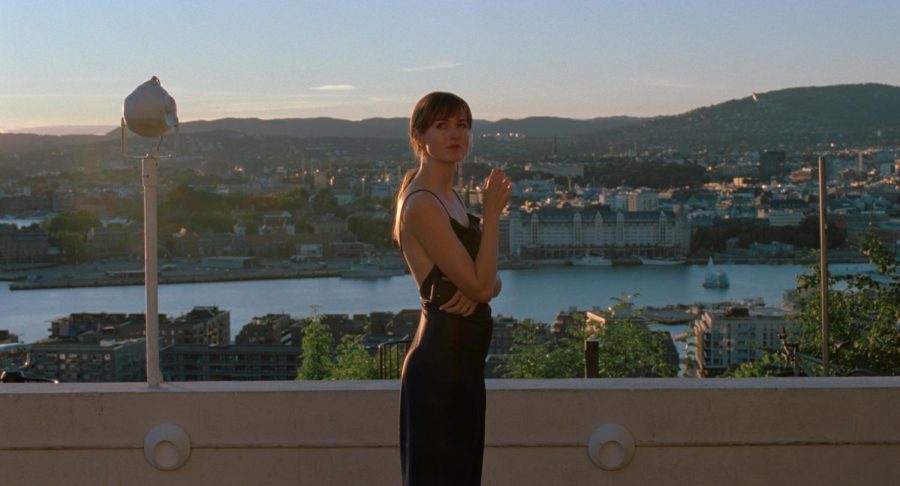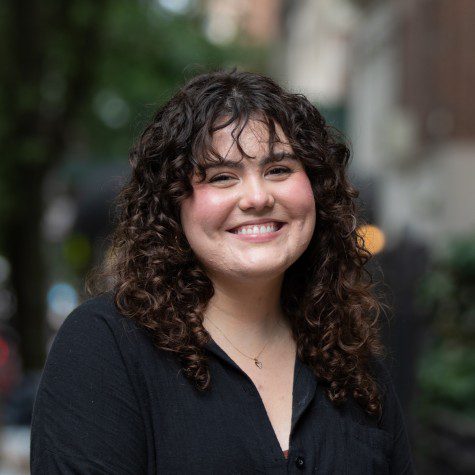Review: ‘The Worst Person in the World’ investigates the perpetual uncertainty of adulthood
Norwegian director Joachim Trier’s third tribute to Oslo, “The Worst Person in the World,” follows Julie as she navigates self-love, romance and the intersection of the two.
In “The Worst Person in the World,” Julie (Renate Reinsve) battles the highs and lows of romance and self-love. Joachim Trier’s coming-of-age film seeks to show the cyclical nature of relations through its 12-chapter structure. (Image courtesy of NEON)
February 22, 2022
Title sequences say a lot about a film. Marvel movies famously open with an intricate animation, while genre films, such as the romantic comedy, often opt for character montages set to music. Joachim Trier’s “The Worst Person in the World” (2021) features simple, bold primary colors in its introduction. The titles also make a reappearance at the end of the film, reflecting Trier’s views on the cyclical nature of life and relationships.
The film is told in 12 chapters and opens with a prologue introducing Julie (Renate Reinsve), a near-30-year-old stumbling through adulthood. When we first meet her, she’s a reluctant medical student who quickly abandons her potential career in favor of psychology, before deciding her true passion is photography — before ultimately landing a practical bookstore gig.
Everything in her life is unstable and ever-changing, from her hair — long and bright-blonde at one point, short and pink at another —to her boyfriends — a sleazy professor or a tall, hairless model. Most of the film, however, follows Julie’s relationship with Aksel (Anders Danielsen Lie), a somewhat cocky, vaguely sexist graphic novelist in his 40s who Julie claims to fall in love with the moment she’s rejected by him. On the other end is Eivind (Herbert Nordrum), a barista whom Julie meets at a party and who is dating a yoga-obsessed environmentalist. Where Julie despises Aksel’s inability to feel things without analyzing them, she resents Eivind for his tendency to do the opposite.
“The Worst Person in the World” more elegantly evokes the romantic realism explored in “500 Days of Summer,” which flips romantic tropes and reveals the consequences of — and, ultimately, growth resulting from — disillusionment in relationships. Trier proves that there is no age limit on the coming-of-age film, delivering an anti-romantic comedy that focuses on how love and relationships shape individual identity — not the other way around.
Reinsve gracefully adopts Julie’s insecurities and complexities in a remarkably emotional performance, making even a two-hour film feel like an insufficient amount of time with her. Despite his initial role as romantic antagonist, Lie’s Aksel proves to be one of the film’s biggest heartbreaks, while Nordrum’s Eivind shines in one of recent cinema’s most charming meet-cute narratives.
Trier’s take on filmmaking combines naturalistic sequences with dreamlike ones for a more involved viewing experience, simultaneously subverting genre conventions. In an attempt to consider what life would be like if she had made different choices, there is a scene in which Julie runs through the frozen streets of Oslo to the sound of Ola Fløttum’s dreamy score. Desperately in need of control, she figuratively –– and literally –– flips a switch, stopping time; on the verge of a serious conversation with Aksel, she breaks into a sprint as she heads to the coffee shop where Eivind works.
Part of the magic of the film is the unique lens it applies to Oslo, ensuring that no other city has ever looked as beautiful. Only Julie and Eivind are in motion, allowing them to spend the day together without the influence of their partners — or the world — around them.
But this idealized, fantasy version of what their relationship could be proves that the ease with which Julie seems to enter into relationships isn’t actually sustainable. There’s a difference between your initial perception of someone and who they really are, and Julie’s problem is that she often forgets this. In a particularly tongue-in-cheek expression of her personality, she adjusts the hands of a couple frozen mid-kiss before winking at the camera and heading home, reluctantly returning to reality.
In an interview discussing the film’s more philosophical pursuits, Trier paraphrases Danish philosopher Søren Kierkegaard, who said, “We can only understand our life backwards, but we’re forced to live it forwards.”
This confusion drives Julie’s personal, professional and romantic choices, which only feel validated at the end of the film when we realize how they have shaped her into a more fully formed version of herself. Everything from its novelistic structure to Kasper Tuxen’s resonant cinematography marks “The Worst Person in the World” as one of the best films of this year — and, arguably, of this decade. Nominated in the 94th Academy Awards for best international feature film and best original screenplay, you can fall in love, laugh, cry and redirect the course of your entire life alongside Julie.
Contact Lorena Campes at [email protected].

























































































































































